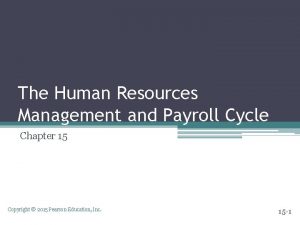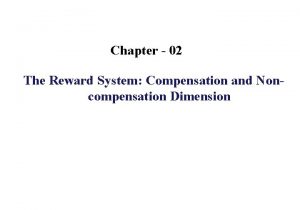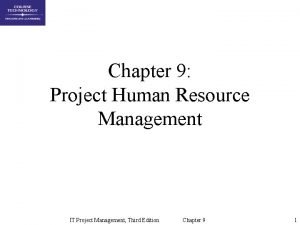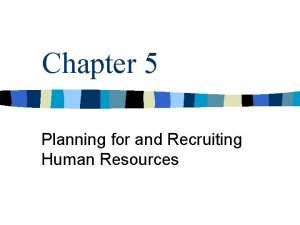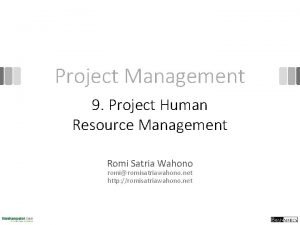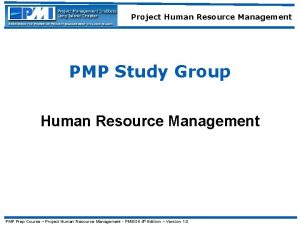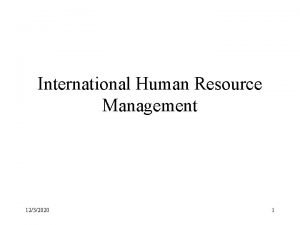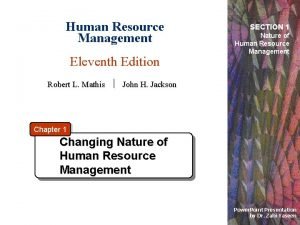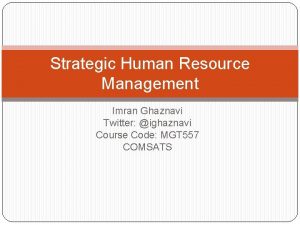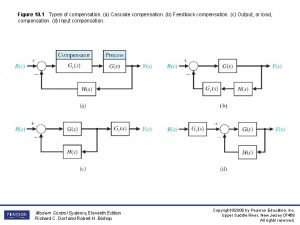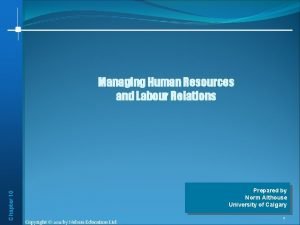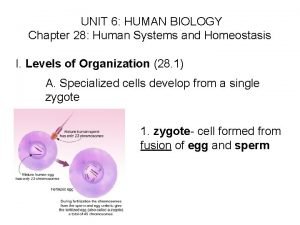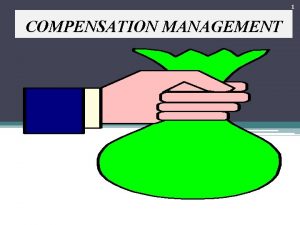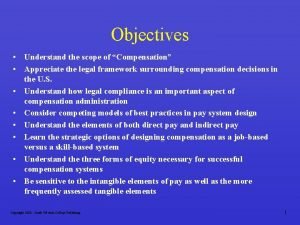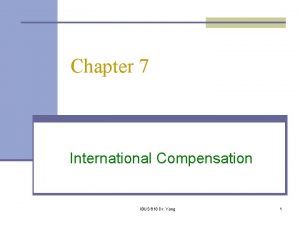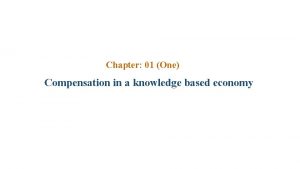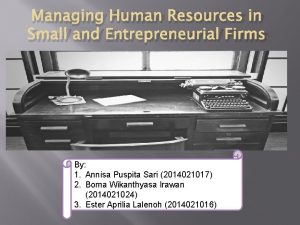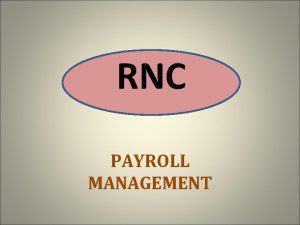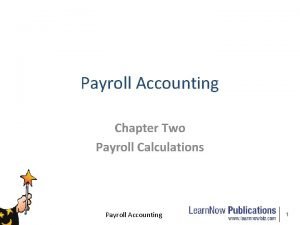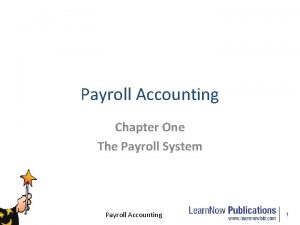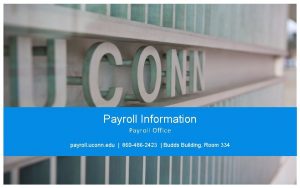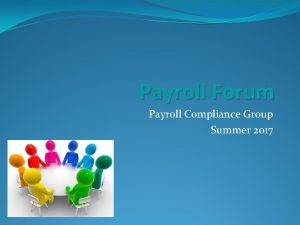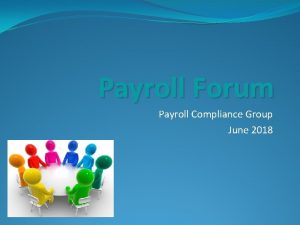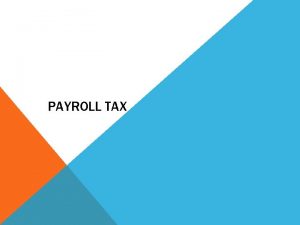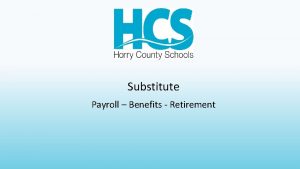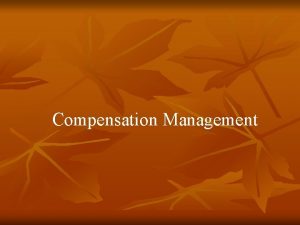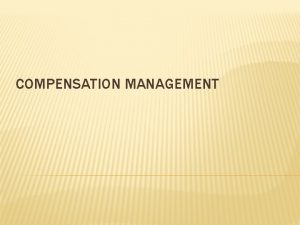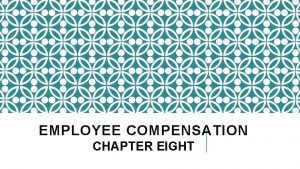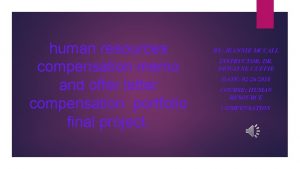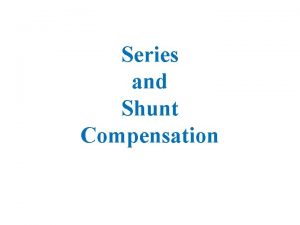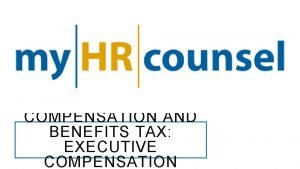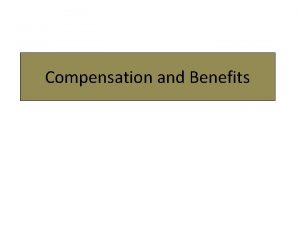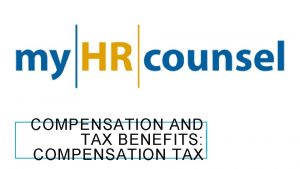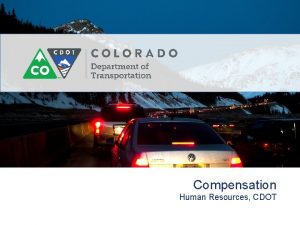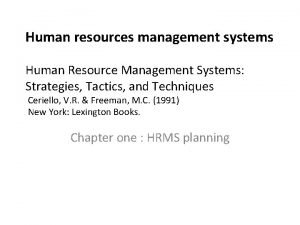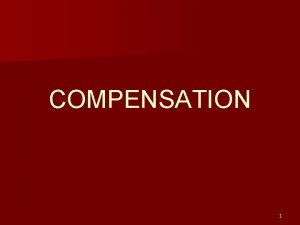HUMAN RESOURCES MANAGEMENT SYSTEMS Compensation and Payroll Chapter









































- Slides: 41

HUMAN RESOURCES MANAGEMENT SYSTEMS Compensation and Payroll Chapter 10 Copywrite C 1999 PMi www. pmihrm. com

Human Resources Management Systems: A Practical Approach n By Glenn M. Rampton, Ian J. Turnbull, J. Allen Doran ISBN 0 -459 -56370 -X Carswell Copywrite C 1999 PMi www. pmihrm. com

Introduction Historically, the need to handle large amounts of information accurately, led to the early automation of payroll and related functions. Many human resources management information systems evolved from adding a broader range of capabilities to what started out as payroll systems Copywrite C 1999 PMi www. pmihrm. com

Compensation/Payroll Model n. Level 1 refers to the global, strategic context. n. Level 2, between the strategic context and the "hands-on programmes", represents the planning and development programs n Level 3 refers to the practical, hands-on functions , for example: job evaluation, linking performance appraisal processes with pay-for-performance, and individual salary determination. n. Level 4, reflects the monitoring and auditing processes which ensure that compensation/payroll programmes, in support of, and in conjunction with other functions in the organization are operating as they should. Copywrite C 1999 PMi www. pmihrm. com

Compensation/Payroll Model (cont’d) An organization's compensation strategy is generally influenced by: nthe organization's financial situation -- how much it can pay; nthe salary market -- how much other organizations are paying for similar jobs; nhow much the organization wants to pay compared to the competition nhow the organization is going to pay its employees - that is, the payroll function. Copywrite C 1999 PMi www. pmihrm. com

Salary Market Surveying Many organizations keep track of the salary rates paid by others in their industrial sectors, and outside, by participating in, and subscribing to published salary surveys. Other organizations prefer to conduct their own surveys. This information may be entered into the HRMS and used as a context against which to conduct analyses to determine a salary policy line. Copywrite C 1999 PMi www. pmihrm. com

Salary Policy Line A salary policy line outlines the salary that the organization wishes to pay at each job evaluation level. n The difference between the actual salary line (what the organization is actually paying at each job evaluation level) and the salary policy line represents the salary adjustments required to bring actual salaries into line with the established salary policy line. n Copywrite C 1999 PMi www. pmihrm. com

Salary Policy Line (Cont’d) n n n Salary policy lines may be established in different ways, for different purposes. Traditionally, however, salary policy lines have been established by senior management based the organization's compensation strategy and knowledge of external salary conditions. The organization's compensation strategy should be based on the strategic/business plans of the organization since the salaries paid by the organization will reflect the quality and availability of human resources. Strategically, some organizations decide that they want to pay above average salaries for their sector, while some organizations want to pay average salaries. Copywrite C 1999 PMi www. pmihrm. com

Job/Position Definition Job requirements derive from organizational requirements as reflected in strategic/business plans. Traditionally job requirements have been documented in formatted job descriptions. Increasingly, job surveys are being used to gather this information. Well prepared job surveys can have the advantages of: being more objective, requiring less time and effort to complete, and being more easily automated. Copywrite C 1999 PMi www. pmihrm. com

Work Planning and Review Job requirements provide the context or mandate against which individual work goals may be developed. Performance against these at the end of the performance period may be assessed and used to determine merit pay, in those organizations that use merit as a determinate of pay increases. Copywrite C 1999 PMi www. pmihrm. com

HRMS Requirements Data Organization For cost-effective updating and ease of data handling, all major data elements should be "table driven", that is, the possible values of each data element should be defined in tables that can easily be referred to in ongoing applications, and amended as changes are required. Such changes may be necessary because of evolving organizational requirements, or new legislation (e. g. , new taxes, or new employment equity reporting requirements). Copywrite C 1999 PMi www. pmihrm. com

HRMS Requirements (Cont’d) Position Management. The HRMS must be position driven. Positions must be linked to a job to obtain salary and employment equity attributes. Copywrite C 1999 PMi www. pmihrm. com

HRMS Requirements (Cont’d) Job Information. The HRMS must have a Job Class Table to store salary information as well as NOC (national occupational code) and OC (occupational codes) used for coding jobs for employment equity purposes. Copywrite C 1999 PMi www. pmihrm. com

HRMS Requirements (Cont’d) Organization An organization table must link to positions and have the attributes necessary to track costs. A location table must also link to the employee to identify actual work and/or mailing location. Copywrite C 1999 PMi www. pmihrm. com

HRMS Requirements (Cont’d) Affiliation An affiliation table is necessary to record the major affiliation(s) of each employee, whether this be employment function, professional affiliation, union affiliation, etc. Copywrite C 1999 PMi www. pmihrm. com

HRMS Requirements (Cont’d) Seniority The HRMS must provide a field that can be updated manually to reflect Seniority Date. Copywrite C 1999 PMi www. pmihrm. com

HRMS Requirements (Cont’d) Attendance Management The HRMS must provide sufficient fields and capacity to record all absences by type, date, paid/unpaid, etc. Copywrite C 1999 PMi www. pmihrm. com

HRMS Requirements (Cont’d) Employee/Position History The HRMS Must track all individual appointments, showing all jobs held. It must also track who is, and has been in each position. Copywrite C 1999 PMi www. pmihrm. com

HRMS Requirements (Cont’d) Performance Evaluation The HRMS must provide for the tracking of goals and objectives; performance intervals and evaluation. Copywrite C 1999 PMi www. pmihrm. com

HRMS Requirements (Cont’d) Employment and Pay Equity The HRMS must provide for the tracking of goals and objectives; performance intervals and evaluation. Copywrite C 1999 PMi www. pmihrm. com

HRMS Requirements (Cont’d) Deductions The HRMS must provide for the tracking of goals and objectives; performance intervals and evaluation. Copywrite C 1999 PMi www. pmihrm. com

HRMS Requirements (Cont’d) Salaried Employees The payroll system must be capable of accurately calculating the pay for each salaried employee. Salary must be calculated according to the number of days (entitled to be paid) if the employee starts/stops work during a pay period. The HRMS must calculate additional pay if additional pay is earned. Adjustments must be able to be made accordingly. Copywrite C 1999 PMi www. pmihrm. com

HRMS Requirements (Cont’d) Hourly Employees The system must be capable of accurately calculating the pay for each hourly paid employee according to the rate of pay and hours worked. A complication in some organizations for both salaried and hourly employees is that individuals may work at multiple jobs at multiple rates of pay for different cost centres during a pay period. Copywrite C 1999 PMi www. pmihrm. com

HRMS Requirements (Cont’d) Hourly Employees The system must: nproduce, on demand, time sheets for each employee and/or work unit; ntrack and analyze shift pay differentials; nstore and report on a variety of salary related data including: leave of absences, sick leave, workers compensation, union duty and other union business including union education, and vacation; and, nhave provision for extra fields for information that will be required in the future. Copywrite C 1999 PMi www. pmihrm. com

HRMS Requirements (Cont’d) Year-to-Date Information The system must be able to accumulate earnings, and deductions, and to display year-to -date information. Copywrite C 1999 PMi www. pmihrm. com

HRMS Requirements (Cont’d) Record of Employment The system must be able to produce accurate records of employment as required. Copywrite C 1999 PMi www. pmihrm. com

HRMS Requirements (Cont’d) Income Tax Statements The system must be able to produce accurate income tax statements at year-end. In Canada these are known as T 4 s (Statement of Remuneration Paid) or T 4 As (Statement of Pension, Retirement, Annuity, and other income). In addition to the paper forms provided to each individual at year end, the system must also be able to produce electronic records of all T 4 s for government purposes (i. e. , Revenue Canada). Copywrite C 1999 PMi www. pmihrm. com

HRMS Requirements (Cont’d) Retroactive Pay The system must track all pay events and facilitate the calculation of retroactive pay. Copywrite C 1999 PMi www. pmihrm. com

HRMS Requirements (Cont’d) Health Tax In jurisdictions to which it applies, the payroll system must be able to calculate and remit payroll-related health tax. Copywrite C 1999 PMi www. pmihrm. com

HRMS Requirements (Cont’d) Lieu Time Where it applies, the system must be able to track time off in lieu of overtime. This must link to Attendance Management Copywrite C 1999 PMi www. pmihrm. com

HRMS Requirements (Cont’d) Pension Reports The system must be able to track and report all pension deductions. Copywrite C 1999 PMi www. pmihrm. com

HRMS Requirements (Cont’d) Leaves of Absence The system must be able to track periods of leave of absence, with and without pay, maternity leave, unpaid sick leave, etc. Copywrite C 1999 PMi www. pmihrm. com

HRMS Requirements (Cont’d) Short and Long Term Disability If applicable, the system must continue to pay the employee on Short Term Disability (STD) if the employee has sick leave accumulated. The system must be able to track and administer long term disability (LTD) where this is required. Copywrite C 1999 PMi www. pmihrm. com

HRMS Requirements (Cont’d) Mass Changes The payroll system must be capable of making mass changes of data, such as when pay increases are processed. Major data entities, such as organizations and jobs, must be table-driven. A name change to an organization unit in a table will result in a name change of the organization of all employees linked to that organization. Copywrite C 1999 PMi www. pmihrm. com

HRMS Requirements (Cont’d) Time and Attendance A payroll system must have the capability to accurately capture, analyze, and report attendance on the job, as well as the time worked in the various categories for which an individual is eligible. Because of the complexity of “time and attendance”, many HRMS’s have special modules for this purpose. Copywrite C 1999 PMi www. pmihrm. com

HRMS Requirements (Cont’d) Spreadsheet Interface The system must be able to interface with popular spreadsheets such as Lotus 1 -2 -3 for downloading of pay information for analysis. Copywrite C 1999 PMi www. pmihrm. com

HRMS Requirements (Cont’d) Interfacing with Other Systems The HRMS containing the payroll system must be able to interface with accounting and other systems to ensure that most effective use is made of the organization's corporate information resources. Copywrite C 1999 PMi www. pmihrm. com

HRMS Requirements (Cont’d) Audit Trails The payroll system must be able to provide a complete record of all pay transactions, including employee, amount paid, pay type, cost centre, date paid. Copywrite C 1999 PMi www. pmihrm. com

Question 1 In some organizations pay and employment equity information is maintained in systems separate from the HRMS. The reason for this is to maintain confidentiality with respect to the pay and employment equity data, and to ensure that this data is not used as the basis for administrative decisions. Do you agree with this approach? Can you think of pragmatic alternatives? . Copywrite C 1999 PMi www. pmihrm. com

Question 2 What are some reasons that the HRMS in many organizations evolved out of the automation of compensation and payroll processes rather than from other HR functions? Copywrite C 1999 PMi www. pmihrm. com

Question 3 In some organizations payroll is part of Finance, while in others it is with Human Resources. Please explain the pros and cons of having it report to either of these functions. Copywrite C 1999 PMi www. pmihrm. com
 Payroll cycle activities
Payroll cycle activities Compensation and non compensation dimensions
Compensation and non compensation dimensions Payroll accounting entries
Payroll accounting entries Define human resource management and payroll cycle
Define human resource management and payroll cycle Chapter 9 human resource management
Chapter 9 human resource management Human resources introduction
Human resources introduction Chapter 9 human resources management
Chapter 9 human resources management Operations management chapter 10
Operations management chapter 10 Hrm question paper 2020
Hrm question paper 2020 Chapter 2 economic resources and systems
Chapter 2 economic resources and systems Chapter 8 human resources culture and diversity
Chapter 8 human resources culture and diversity Chapter 8 human resources culture and diversity
Chapter 8 human resources culture and diversity Chapter 5 human resource planning and recruitment
Chapter 5 human resource planning and recruitment Project management human resources
Project management human resources Human resource management plan pmp
Human resource management plan pmp Important of hrm
Important of hrm Empower human resources management
Empower human resources management Meaning of personal management
Meaning of personal management Retail organization and human resource management
Retail organization and human resource management Human resource management weiterbildung
Human resource management weiterbildung Human resource management gaining a competitive advantage
Human resource management gaining a competitive advantage Hrm nature
Hrm nature Time management in human resource management
Time management in human resource management Twitter
Twitter Advantages of external recruitment
Advantages of external recruitment The role of psychology in human resources management
The role of psychology in human resources management Transformed and transforming resources
Transformed and transforming resources Fixed resources
Fixed resources Richard dorf
Richard dorf Chapter 27 human impact on earth resources
Chapter 27 human impact on earth resources Chapter 10 managing human resources
Chapter 10 managing human resources Chapter 28 human systems and homeostasis
Chapter 28 human systems and homeostasis Chapter 8 human needs and human development
Chapter 8 human needs and human development Chapter 8 human needs and human development
Chapter 8 human needs and human development Renewable vs nonrenewable resources worksheet
Renewable vs nonrenewable resources worksheet Objectives of compensation cum reward system
Objectives of compensation cum reward system Scope of compensation
Scope of compensation Expatriate compensation worksheet
Expatriate compensation worksheet Compensation management in a knowledge-based world
Compensation management in a knowledge-based world Managing human resources in small and entrepreneurial firms
Managing human resources in small and entrepreneurial firms Employee selection
Employee selection Managing human resources in small and entrepreneurial firms
Managing human resources in small and entrepreneurial firms
